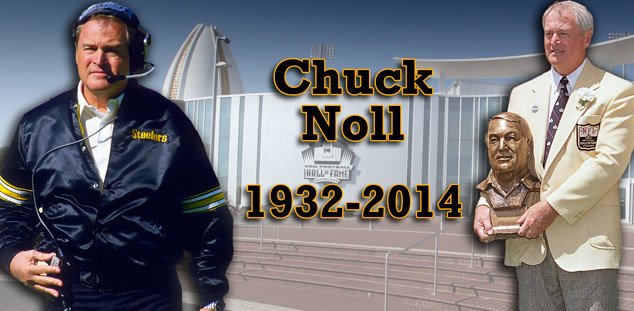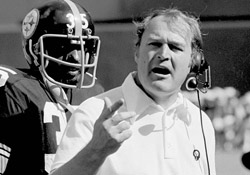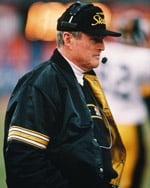Chuck Noll, 1932-2014
Hall of Famers
Published on : 6/14/2014

Hall of Fame Coach Chuck Noll passed away Friday evening as the age of 82.
Noll is the only man in National Football League history to coach his team to four Super Bowl titles.
“Chuck Noll’s impact on the history of this game goes without saying,” stated Pro Football Hall of Fame President David Baker. “He epitomized the very excellence that we celebrate at the Hall of Fame. Chuck’s leadership helped the Pittsburgh Steelers to unprecedented dominance that will forever be remembered.
“On behalf of all his fellow Hall of Famers and all of us at the Hall of Fame, we express our sincerest sympathies to the Noll family.”
The Steelers, first known as Pirates, joined the National Football League in 1933. For almost 40 years, they did not win a championship of any kind. Then in 1969, Noll was hired to lead the team. In just a few seasons, the Steelers were the toast of the pro football world as the dynasty team of the 1970s.
In his fourth season in 1972, Noll brought Pittsburgh its first-ever championship, the AFC Central division crown. Two years later, the Steelers began an unprecedented period of dominance with four Super Bowl victories in a six-season span between 1974 and 1979.
 Noll recorded 209 coaching victories, the sixth most ever, in his 23 years with the Steelers that ended after the 1991 season. In addition to his four Super Bowl victories, Noll guided the Steelers to nine Central division titles and 15 winning seasons in his last 20 years.
Noll recorded 209 coaching victories, the sixth most ever, in his 23 years with the Steelers that ended after the 1991 season. In addition to his four Super Bowl victories, Noll guided the Steelers to nine Central division titles and 15 winning seasons in his last 20 years.In 1993, in his first year of eligibility, Noll was accorded pro football's ultimate honor, election to the Pro Football Hall of Fame.
To fully understand the magnitude of Noll's accomplishment, it is important to consider how things were in Pittsburgh before he arrived. Fifteen coaches tried their hand at leading the Steelers before Noll arrived. Only Buddy Parker, with a 51-47-6 record in eight years from 1957 to 1964, had any measure of success.
Bill Austin was the last Steelers coach of the pre-Noll years. Early in his tenure, Art Rooney Sr., the beloved team founder and owner, decided that the Steelers were once again on the wrong track. This time, he told his son Dan that he should pick the next coach.
Dan Rooney had plenty of time to make a decision because his father insisted on honoring the three-year contract he had given to Austin. There was some sentiment for established NFL assistants and fan enthusiasm for a name college coach such as Joe Paterno or an Ara Parseghian. But Rooney eventually settled on the 37-year-old Noll, at the time the defensive backfield coach of the Baltimore Colts.
While Noll was understandably eager to become an NFL head coach, accepting the Pittsburgh job was not an easy decision. There were other openings at the time and there was the history of what happened to Pittsburgh coaches in the past. Eventually, he took the Rooneys at their word on their commitment to provide total support in helping to build the Steelers into contenders.
Noll's first decision – the drafting of defensive tackle Joe Greene from North Texas State – didn't please long-suffering Steelers fans, who had envisioned a high-powered quarterback or a big-yardage running back with the No. 1 pick. But the selection of Greene was the first step in Noll's massive rebuilding program which he said from the start would be concentrated on the annual draft of college stars, rather than any reliance on trades for what often were "other team's problems."
Particularly in the first few years, Noll's drafting program went exceptionally well. Every year, he managed to land a potential superstar -- L.C. Greenwood in addition to Greene in 1969, Terry Bradshaw and Mel Blount in 1970, Jack Ham, Dwight White and Mike Wagner in 1971, Franco Harris in 1972, and Lynn Swann, Jack Lambert, John Stallworth and Mike Webster in 1974. Six of those Steelers preceded Noll into the Pro Football Hall of Fame.
Noll won his first game against the Detroit Lions in 1969 and then lost 13 straight. The new coach insisted that the Steelers would get better and they did. They won five games in 1970 and six in 1971 and began to attract the attention of their NFL opponents.
Linebacker Andy Russell was one of the quality holdovers from the "old" Steelers who stayed around long enough to win a Super Bowl ring. He quickly noted the transformation of the Steelers under Noll.
"He was very stern, very strict," Russell said. "On the other hand, he was very realistic about what the players could or could not do. He didn't wear us out at practice. Sundays were our hard days. To that extent, he was a player's coach."
 Everyone knew the Steelers would be much improved in 1972 but they did much better than expected by winning the AFC Central title with an 11-3 record. A 13-7 playoff victory, another first for Pittsburgh, over Oakland followed. Harris' famous "Immaculate Reception" touchdown as time ran out cemented the victory. A week later in the AFC title game, the Steelers gave the Miami Dolphins, on their way to a perfect season, a major scare before succumbing 21-17. Noll's team had to settle for a wild-card playoff berth in 1973 but, in 1974, the Steelers catapulted to the top of the NFL. They won their first of six straight AFC Central crowns, blasted Oakland 24-13 in the AFC championship game and then used an overpowering defense to throttle Minnesota 16-6 in Super Bowl IX. They repeated as world champions by whipping the Dallas Cowboys 21-17 in Super Bowl X.
Everyone knew the Steelers would be much improved in 1972 but they did much better than expected by winning the AFC Central title with an 11-3 record. A 13-7 playoff victory, another first for Pittsburgh, over Oakland followed. Harris' famous "Immaculate Reception" touchdown as time ran out cemented the victory. A week later in the AFC title game, the Steelers gave the Miami Dolphins, on their way to a perfect season, a major scare before succumbing 21-17. Noll's team had to settle for a wild-card playoff berth in 1973 but, in 1974, the Steelers catapulted to the top of the NFL. They won their first of six straight AFC Central crowns, blasted Oakland 24-13 in the AFC championship game and then used an overpowering defense to throttle Minnesota 16-6 in Super Bowl IX. They repeated as world champions by whipping the Dallas Cowboys 21-17 in Super Bowl X.The 1976 Steelers missed in their bid for a "three-peat" when they lost to Oakland in the AFC championship game. In 1977, they advanced only to the first playoff round before losing to Denver. But by 1978 Noll's charges were back in the swing of things and the unprecedented third and fourth Super Bowl triumphs were the result. The Steelers whipped Dallas 35-31 in Super Bowl XIII and then finished off their incredible string with a 31-19 win over the Los Angeles Rams in Super Bowl XIV.
Basically, the Steelers won all four world championships with the same cast of superstars and near-superstars. No fewer than 21 members, including the nine Hall of Famer players, were part of the Steelers Super Bowl dynasty years. It was a tremendous testimony to the stability of the organization as well as to the player acquisition program instituted by Noll a decade earlier.
Noll was born to a German-American family in Cleveland, Ohio, on January 5, 1932. He played football at Benedictine High School and then studied education and captained the football team at the University of Dayton. He was a 21st-round draft pick of the Cleveland Browns in 1953 and he played pro football first as a messenger guard and later as a linebacker for seven years.
After the 1959 season, Noll felt he had a chance to get the head football coaching position at Dayton, his alma mater. He and his wife Marianne discussed the situation and decided that, since he did want to get into coaching, Dayton would be the ideal place to start.
Ironically, Noll didn't get the job but instead embarked on a nine-year apprenticeship as a defensive backfield coach first under Sid Gillman of the Los Angeles/San Diego Chargers. In 1966, he moved to Baltimore to serve under Don Shula.
"You learn something from everyone," Noll said. "Sid was one of the game's prime researchers and offensive specialists. In six years, I had more exposure to football than I normally would have received in 12 years."
From Shula, Noll cited "organization and attitudes" as his legacy. "I also learned from Paul Brown in a different way, because I played for him."
 In spite of his exceptional success with the Steelers, Noll never eliminated an identity problem that dogged him throughout his Pittsburgh tenure. The thousands who watched him on the sidelines on television perceived him to be a cold and emotionless person. In reality, he was intelligent, interested in the arts and travel and a person who loved to discuss all of the national and world issues of the day at great length.
In spite of his exceptional success with the Steelers, Noll never eliminated an identity problem that dogged him throughout his Pittsburgh tenure. The thousands who watched him on the sidelines on television perceived him to be a cold and emotionless person. In reality, he was intelligent, interested in the arts and travel and a person who loved to discuss all of the national and world issues of the day at great length."Basically, I am a private person," Noll once said. "My thing is preparation and teaching and that's not a good story. I'm not a one-liner kind of guy. I'm not a comedian."
Personal acclaim did not mean much to Noll. He was the only coach in the NFL without his own television or radio program. With one exception as a favor for a friend, he refused to participate in paid commercials. "Go to one of the players," he always said when requests came his way.
Nor was he interested, per se, in money. One Steeler insider noted: "It's been years since anybody here has bothered to discuss contract with Noll." Noll insisted he had never made a decision in his life based on money considerations.
Noll preferred to think of himself as a teacher and, even after the Steelers became so successful that his duties became time-consuming, he still coached individuals, mostly on basic techniques, whenever he could.
"One-on-one after practice is best for me."
As the Steelers legend grew, most agreed that the team was successful because of its great players. But those same people quickly acknowledged that it was Noll who had handpicked the playing talent. Also of great importance was the patience that Noll showed in waiting for his players to develop.
Bradshaw was in his fifth season before he won the starting quarterback job for good. Harris didn't start until everybody ahead of him had been injured. The best center in the league, Mike Webster, shared the starting job for several years with Ray Mansfield.
It was also important to the Steelers' success of the 1970s that the Rooneys never wavered in their support of Noll even though he was a 12-30 loser the first three years. Convinced he could do the job, they simply waited patiently for the Stealers to become a winner.
As a coach, Noll employed all of the techniques used by other successful coaches. He put a priority on gaining four yards on first down. While he would rather run than pass "because football is a game of contact," he switched more to the passing game when the trend in football turned that way.
Above all, Noll put an emphasis on winning against teams that finished under .500. During an eight-year span beginning in 1972, they won an incredible 59 of 60 games against the so-called weaker teams. His record at the same time against teams finishing above .500 was undistinguished 29-26-1. In postseason play, however, his Steelers were 13-4 during that period.
 Although Noll was strictly all business on the field and on the sidelines during games, the welfare of his players concerned him a great deal.
Although Noll was strictly all business on the field and on the sidelines during games, the welfare of his players concerned him a great deal. "To the people on the outside looking in, Chuck was very uncaring and stoic about his players," Ham once said. "In reality, he cared immensely about his players."
When defensive end Dwaine Board was drafted in 1979 and he seemed likely to win a starting job, it meant Noll would have to cut veteran Dwight White. But Noll, mainly out of loyalty, could not bring himself to cut the veteran star. He never forgot the time White came out of the hospital, 30 pounds lighter, to play in Super Bowl IX against the Vikings.
With rare exceptions, his only action on the sideline was what the Steelers called the glare. When things went sour, Noll simply stared -- a cold, steely, piercing, unnerving stare – at the player who erred. "If you were on a wrong end of a Chuck Noll glare," Chuck Wolfley said, "that was all the proper motivation you needed."
Thus, when Noll learned of his election to the Pro Football Hall of Fame, he was somewhat embarrassed because he firmly believed he was no more responsible than many other people for the Steelers' great successes.
But Ham had a quick answer to Noll's response. "I think of all the people who were involved in the Steelers organization during our Super Bowl years," he said, "Chuck Noll is by far the most deserving to be inducted into the Pro Football Hall of Fame."
Previous Article
Photo Gallery: Chuck Noll, Class of 1993
View photos from Noll's career.
Next Article
Hall of Fame Fathers and Sons
Four Hall of Fame members have sons who were active in the NFL during the 2013 NFL season and one who will join the league this year.